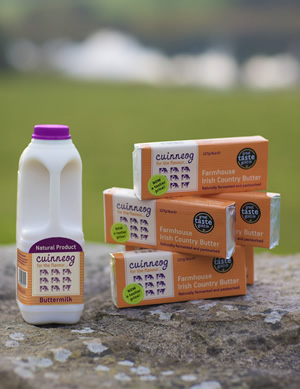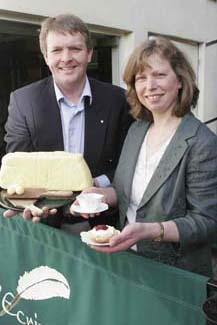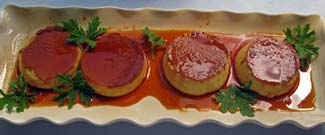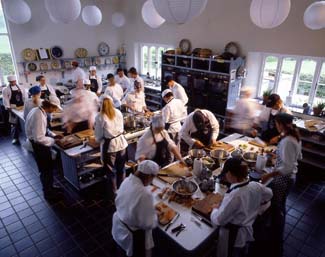The Darina Allen Column - Artisan Milk & Handmade Butter
 The artisan milk and handmade butter movement is really gathering momentum, it is still minute but boy is it causing a stir. Single estate milk is a new growth area in Irish food.
The artisan milk and handmade butter movement is really gathering momentum, it is still minute but boy is it causing a stir. Single estate milk is a new growth area in Irish food.
Many top restaurants are now featuring handmade butter proudly on their tables and at last a growing number of dairy farmers are putting milk back into glass bottles and selling organic non-homogenised milk and butter. I sense the same passion as in the artisan brewing movement and as with the brewers there’s a generosity of spirit and room for many more.
Tom and Sheila Butler have been making Cuinnéog Irish country butter and buttermilk In Shraheens, Balla, Co Mayo since 1990. They won a coveted Great Taste Award in 2011.
Alan and Valerie Kingston from Glenilen Farm in Drimoleague, West Cork are also trail blazers, adding value to their beautiful milk from their Friesian and Jersey cows in a myriad of ways, yoghurt, butter (winner of an Irish Food Writers’ Guild Award), traditional and clotted cream, strawberry smoothies, cheese cakes, lemon posset and of course freshly pasteurised milk in litre glass bottles. At Mahon Point Farmers Market, devotees fill their bottles with chilled pasteurised milk or melt chocolate lollipops in hot milk – how fun and gorgeous is that!
 In 1997, using the milk from their herd of fifty five cows they started to make cheesecakes for the local country markets - what started as a hobby continued to grow and has transformed their small farm into a hive of activity which now employs thirty four people.
In 1997, using the milk from their herd of fifty five cows they started to make cheesecakes for the local country markets - what started as a hobby continued to grow and has transformed their small farm into a hive of activity which now employs thirty four people.
Alan and Valerie Kingston truly know that it all starts with the quality of the milk, “we treat our cows kindly allowing them to roam, keeping them warm in Winter and never ever over milk them” – a simple but crucial factor in their success. And, like Cuinneog, when Bord Bia wanted to give Queen Elizabeth a taste of our most delicious and best, Glenilen Farm milk, butter, cream and crème fraiche was on the menu. Mark Kingston of Golden Bean uses Glenilen milk for his superb lattes and cappuccinos.
The newest enterprise I’ve discovered is Ballymore Farm Organic Dairy near Ballymore in the foothills of the Wicklow Mountains in County Kildare. Aidan Harney and his wife Mary Davis are the energy and inspiration behind this enterprise. From the milk of their Jersey, Ayrshire and Friesian cows they produce raw organic milk, handmade butter, buttermilk, yoghurt and cream. The graphics, reminiscent of Zingermans in Ann Arbor in Michigan, are fun and catchy and once again the demand for their products is skyrocketing. At the recent Bord Bia Food promotion in Selfridges in London they were one of many artisan producers who sold out well before the end of the promotion. Contact www.ballymorefarm.ie for stockists.
Organic Mossfield Farm near Birr in Co Offaly have been selling pasteurised organic milk since November last and Ralph Haslam tells me that sales are building all the time. Sheridans Cheesemongers have experienced a 800% increase in demand for David Tiernan’s unpasteurised milk since they started to stock it in November 2010.
This growing interest in handmade artisan food products gives farmers the opportunity to add value to their raw material and create much needed local employment. Linking food with tourism is an obvious growth opportunity for Ireland’s farmers, fishermen, and artisan food producers. Restaurants and food businesses that feature local foods on their menu already experience an increase in business and benefit from the goodwill it generates when they support their local producers. This was clearly illustrated in the recent Grant Thornton report commissioned by Good Food Ireland on “Opportunities to Link Food to Tourism.”
We have just three Jersey cows here on our organic farm in East Cork so we ourselves, our children and grandchildren can drink raw milk. We sell a little surplus from the farm shop in response to the growing demand for organic milk Some people drive 40 – 50 miles to get it, they loved the taste and are convinced about the health benefits.
RECIPES:
.jpg) Yoghurt and Cardamom Cream with Green Gooseberry and Elderflower Compote
Yoghurt and Cardamom Cream with Green Gooseberry and Elderflower Compote
Elderflowers have an extraordinary affinity with green gooseberries and by a happy arrangement of nature they are both in season at the same time.
Serves 8-10
Yoghurt and Cardamom Cream
425ml (15 fl oz) natural yoghurt
225ml (8 fl oz) milk
150g (5 oz) castor sugar
200ml (7 fl oz) cream
1/4 teaspoon cardamom seeds, freshly ground - you’ll need about 8-10 green cardamom pods depending on size
3 rounded teaspoons powdered gelatine
Green Gooseberry and Compote (see recipe)
2 lb (900g) green gooseberries
2 or 3 elderflower heads
1 pint (600ml) cold water
1 lb (450g) sugar
First make the Yoghurt and Cardamom Cream:
Put the milk, sugar and cream into a stainless steel saucepan with the ground cardamom, stir until the sugar has dissolved and the mixture is warm to the touch. Remove from the heat and leave to sit to infuse while you dissolve the gelatine. Sponge the gelatine in a small bowl with 4 tablespoons of cold water. Put the bowl into a saucepan of simmering water until the gelatine has melted and is completely clear. Add a little of the infused milk mixture and stir well and then mix this into the rest. Beat the yoghurt lightly with a whisk until smooth and creamy, add into the cardamom mixture.
Pour into a well-oiled ring mould or 8 individual moulds. Allow to set for several hours, preferably overnight.
To make the Green Gooseberry and Compote:
First top and tail the gooseberries. Tie 2 or 3 elderflower heads in a little square of muslin, put in a stainless steel or enamelled saucepan, add the sugar and cover with cold water. Bring slowly to the boil and continue to boil for 2 minutes. Add the gooseberries and simmer just until the fruit bursts. Allow to get cold. Serve in a pretty bowl and decorate with fresh elderflowers. Serve with elderflower cream (see above).
N.B. The tart green gooseberries must actually burst otherwise the compote of fruit will be too bitter.
To Serve:
* To crush cardamom seeds, remove the seeds from 6 or 8 pods and crush the seeds in a pestle and mortar or between 2 sheets of silicone paper with the bottom of a saucepan.
Lemon Posset with Rose Scented Geranium
Serves 4
400ml (14fl oz) double cream
100g (3 1/2oz) caster sugar
5 leaves rose-scented geranium
2 fl oz (50 ml) lemon juice
Garnish: tiny rose geranium leaves
Place the cream, sugar and rose geranium leaves in a saucepan and bring to a simmer. Turn down the heat to low and cook, stirring often, for five minutes. Remove the pan from the heat, squeeze in the lemon juice, strain and allow to cool. Serve in small tall glasses each garnished with a tiny rose geranium leaf.
Bhapa Doi – Steamed Sweetened Yoghurt
So maybe this isn’t exactly a traditional recipe, but steamed puddings are certainly a forgotten skill and I ate the most sublime steamed yoghurt at Kempies restaurant in Calcutta. This isn’t exactly the same, but it is delicious also. I found it in The Calcutta Kitchen by Simon Parkes and Udit Sarkhel.
The sweetness of the condensed milk works wonderfully with the acidity of the plain yoghurt. This creamy, sliceable textured pudding is similar to a crème caramel – one of my favourites.
Serves 8
800g (1lb 12 oz) natural yoghurt
300g (10 1/2oz) sweetened condensed milk
seeds of 6 green cardamom pods
powdered in a mortar and pestle
8-10 saffron strands
Garnish: Sliced pistachio nuts
Heat some water in a steamer. You could use a bamboo over a wok, but any multi-tiered steamer will work. If you do not have a steamer, upturn a small, metal, flat-bottomed bowl inside a larger pot with a fitting lid. Pour water into this and bring to a simmer. Put the item to be steamed into a suitable dish, cover with Clingfilm, and place on the upturned bowl to steam.
Mix the natural yoghurt and other ingredients in a bowl and whisk to incorporate some air but don’t overdo it or the whey will separate. Pour it into 8 small serving bowls. Cover with clingfilm and put in the steamer or on to the upturned bowl. Cover with the lid and steam on a steady simmer for 35-40 minutes.
Carefully remove the bowls and leave to cool. Remove the clingfilm and chill.
Serve chilled, sprinkle with the sliced pistachio nuts.

Serves 6
Caramel
8oz (225g) sugar
5 fl ozs (150ml) water
Caramel Sauce
2 1/2 fl ozs (60ml) water
Custard
1 pint (600ml) milk
4 eggs, preferably free range
2 ozs (50g) castor sugar
vanilla pod or 1/2 teaspoon pure vanilla extract (optional)
Caramel Shards (see recipe)
1 x 5 inch (12.5) charlotte mould or 6 x 3 inch (7.5cm) soufflé dishes
First infuse the milk. Put the cold milk into a saucepan and add the vanilla pod if using. Bring to just under boiling point, cool. Whisk the eggs, castor sugar and vanilla extract (if used) until thoroughly mixed but not too fluffy. Whether you are using a vanilla pod or vanilla extract, the milk must be brought to just under boiling point first.
Allow to cool and infuse for 6-10 minutes. Meanwhile, make the caramel. Put the sugar and water into a heavy bottomed saucepan and stir over a gentle heat until the sugar is fully dissolved. Bring to the boil, remove the spoon and cook until the caramel becomes golden brown or what we call a “chestnut” colour. Do not stir and do not shake the pan. If sugar crystals form around the side of the pan, brush them down with cold water. When the caramel is ready for lining the moulds, it must be used immediately or it will become hard and cold. Coat the bottom of the charlotte mould or soufflé dishes with the hot caramel. Dilute the remainder of the caramel with the 2 1/2 fl ozs (60ml/generous 1/4 cup) of the water, return to the heat to dissolve and keep aside to serve around the caramel custard.
Pour the slightly cooled milk onto the egg mixture, whisking gently as you pour. Strain and pour into the prepared moulds, filling them to the top.
Place the moulds in a bain-marie of simmering water, cover with a paper lid and bake in a moderate oven 150C/300F/regulo 2, for 35 minutes approx., for individual dishes, 1 hour approx. for a charlotte mould. Test the custard by putting a skewer in the centre, it will come out clean when the custard is fully cooked.
Cool and turn out onto a round, flat dish or individual plates, put the remaining caramel around. Serve with a little softly whipped cream. Decorate with caramel shards (see recipe below).
** Please remember to allow the milk to cool before whisking onto the egg yolks otherwise the eggs will curdle.
Caramel Shards
Boil sugar and water to the caramel stage – “chestnut” colour - cool slightly, then spoon onto an oiled baking sheet or onto silicone paper. When cold and crisp, use to decorate the crème caramels. Bigger pieces may be splintered into shards.
Alternatively, put 4-6 ozs (110-150g/1/2 – 3/4 cup) sugar either granulated or castor into a low sided stainless steel saucepan. Stir continuously over a medium heat until the sugar melts and caramelises. When it has almost reached the “chestnut” stage, turn off the heat and allow to stand for a few minutes. Then spoon into shapes as above.
***
 Once again this year, the Ballymaloe Cookery School in East Cork has a great programme of cookery courses for all interests and abilities. Ranging from a relaxing visit to sit in on an afternoon cookery demonstration to a week long ‘Intensive Introductory Course’.
Once again this year, the Ballymaloe Cookery School in East Cork has a great programme of cookery courses for all interests and abilities. Ranging from a relaxing visit to sit in on an afternoon cookery demonstration to a week long ‘Intensive Introductory Course’.
Sitting in the middle of a 100 acre organic farm the Ballymaloe Cookery School provides its students not only with a life skill learnt under the expert tutelage of their very capable teachers but also a place to relax and unwind from the stresses and strains of normal everyday life. The cottage accommodation available onsite consists of a collection of delightful converted outbuildings which have been transformed over the years by the Allens.
www.cookingisfun.ie





There are currently no comments
Leave a comment
Not a member? Register for your free membership now!
Or leave a comment by logging in with: